VOLVO S40 2005 User Guide
Manufacturer: VOLVO, Model Year: 2005, Model line: S40, Model: VOLVO S40 2005Pages: 127, PDF Size: 2.32 MB
Page 11 of 127
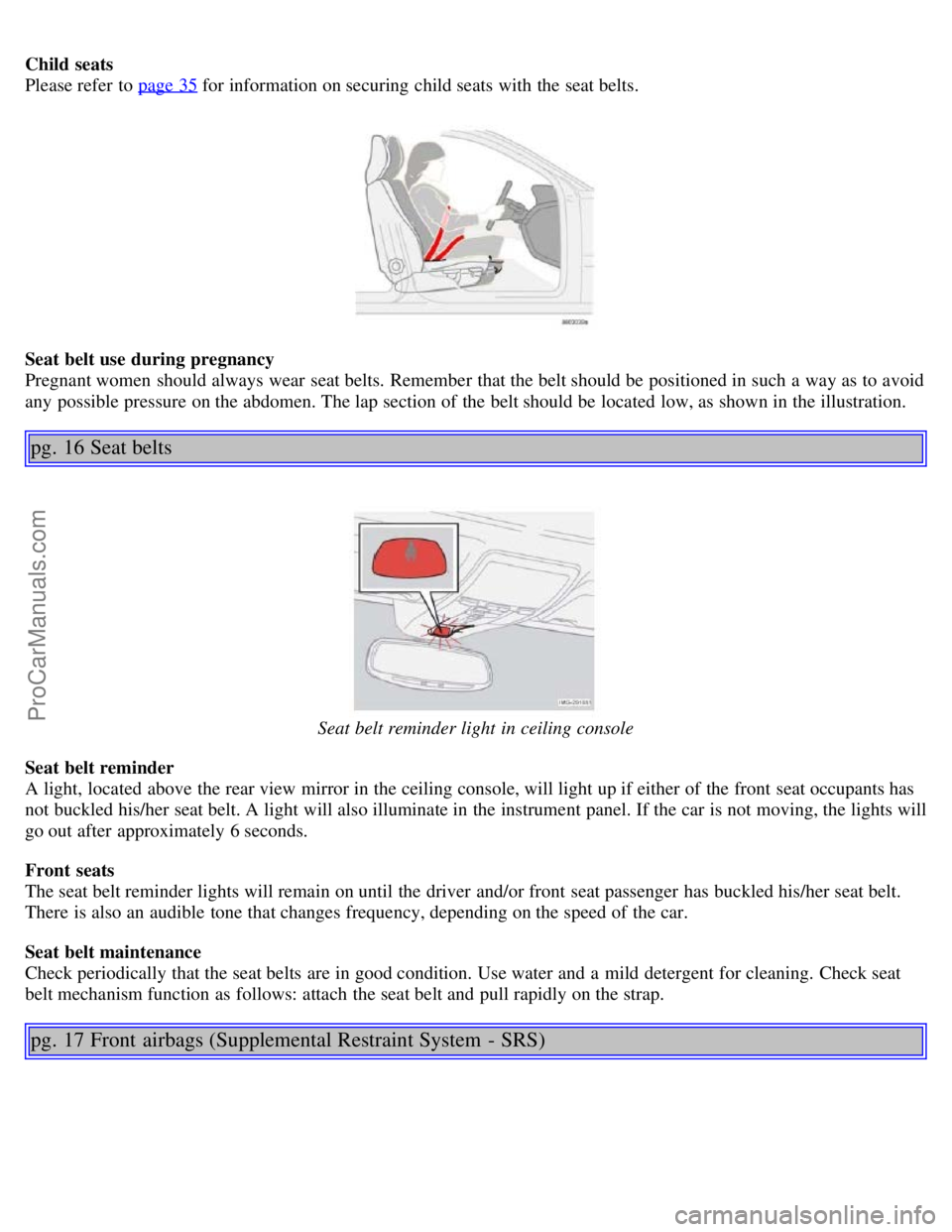
Child seats
Please refer to page 35
for information on securing child seats with the seat belts.
Seat belt use during pregnancy
Pregnant women should always wear seat belts. Remember that the belt should be positioned in such a way as to avoid
any possible pressure on the abdomen. The lap section of the belt should be located low, as shown in the illustration.
pg. 16 Seat belts
Seat belt reminder light in ceiling console
Seat belt reminder
A light, located above the rear view mirror in the ceiling console, will light up if either of the front seat occupants has
not buckled his/her seat belt. A light will also illuminate in the instrument panel. If the car is not moving, the lights will
go out after approximately 6 seconds.
Front seats
The seat belt reminder lights will remain on until the driver and/or front seat passenger has buckled his/her seat belt.
There is also an audible tone that changes frequency, depending on the speed of the car.
Seat belt maintenance
Check periodically that the seat belts are in good condition. Use water and a mild detergent for cleaning. Check seat
belt mechanism function as follows: attach the seat belt and pull rapidly on the strap.
pg. 17 Front airbags (Supplemental Restraint System - SRS)
ProCarManuals.com
Page 12 of 127
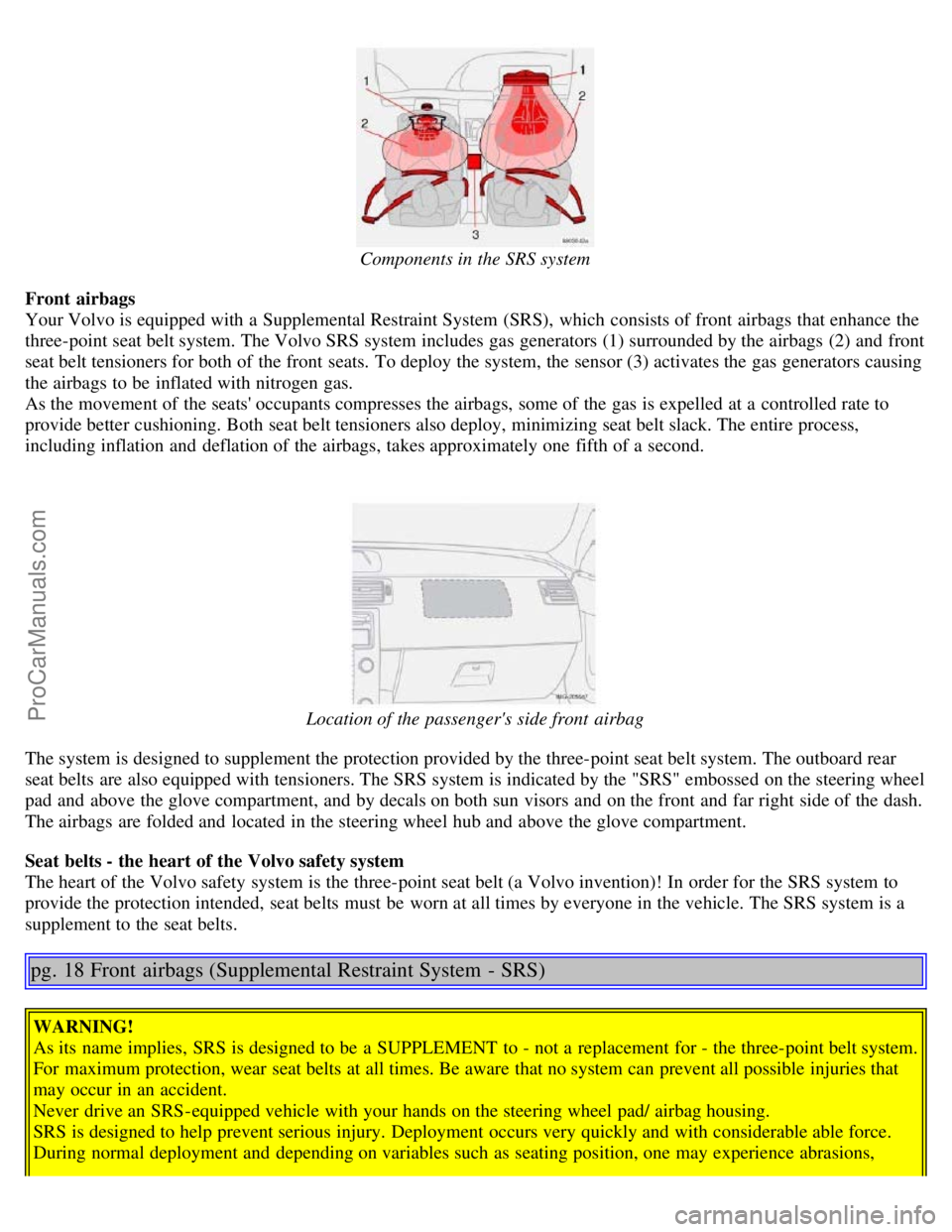
Components in the SRS system
Front airbags
Your Volvo is equipped with a Supplemental Restraint System (SRS), which consists of front airbags that enhance the
three-point seat belt system. The Volvo SRS system includes gas generators (1) surrounded by the airbags (2) and front
seat belt tensioners for both of the front seats. To deploy the system, the sensor (3) activates the gas generators causing
the airbags to be inflated with nitrogen gas.
As the movement of the seats' occupants compresses the airbags, some of the gas is expelled at a controlled rate to
provide better cushioning. Both seat belt tensioners also deploy, minimizing seat belt slack. The entire process,
including inflation and deflation of the airbags, takes approximately one fifth of a second.
Location of the passenger's side front airbag
The system is designed to supplement the protection provided by the three-point seat belt system. The outboard rear
seat belts are also equipped with tensioners. The SRS system is indicated by the "SRS" embossed on the steering wheel
pad and above the glove compartment, and by decals on both sun visors and on the front and far right side of the dash.
The airbags are folded and located in the steering wheel hub and above the glove compartment.
Seat belts - the heart of the Volvo safety system
The heart of the Volvo safety system is the three-point seat belt (a Volvo invention)! In order for the SRS system to
provide the protection intended, seat belts must be worn at all times by everyone in the vehicle. The SRS system is a
supplement to the seat belts.
pg. 18 Front airbags (Supplemental Restraint System - SRS)
WARNING!
As its name implies, SRS is designed to be a SUPPLEMENT to - not a replacement for - the three-point belt system.
For maximum protection, wear seat belts at all times. Be aware that no system can prevent all possible injuries that
may occur in an accident.
Never drive an SRS-equipped vehicle with your hands on the steering wheel pad/ airbag housing.
SRS is designed to help prevent serious injury. Deployment occurs very quickly and with considerable able force.
During normal deployment and depending on variables such as seating position, one may experience abrasions,
ProCarManuals.com
Page 13 of 127
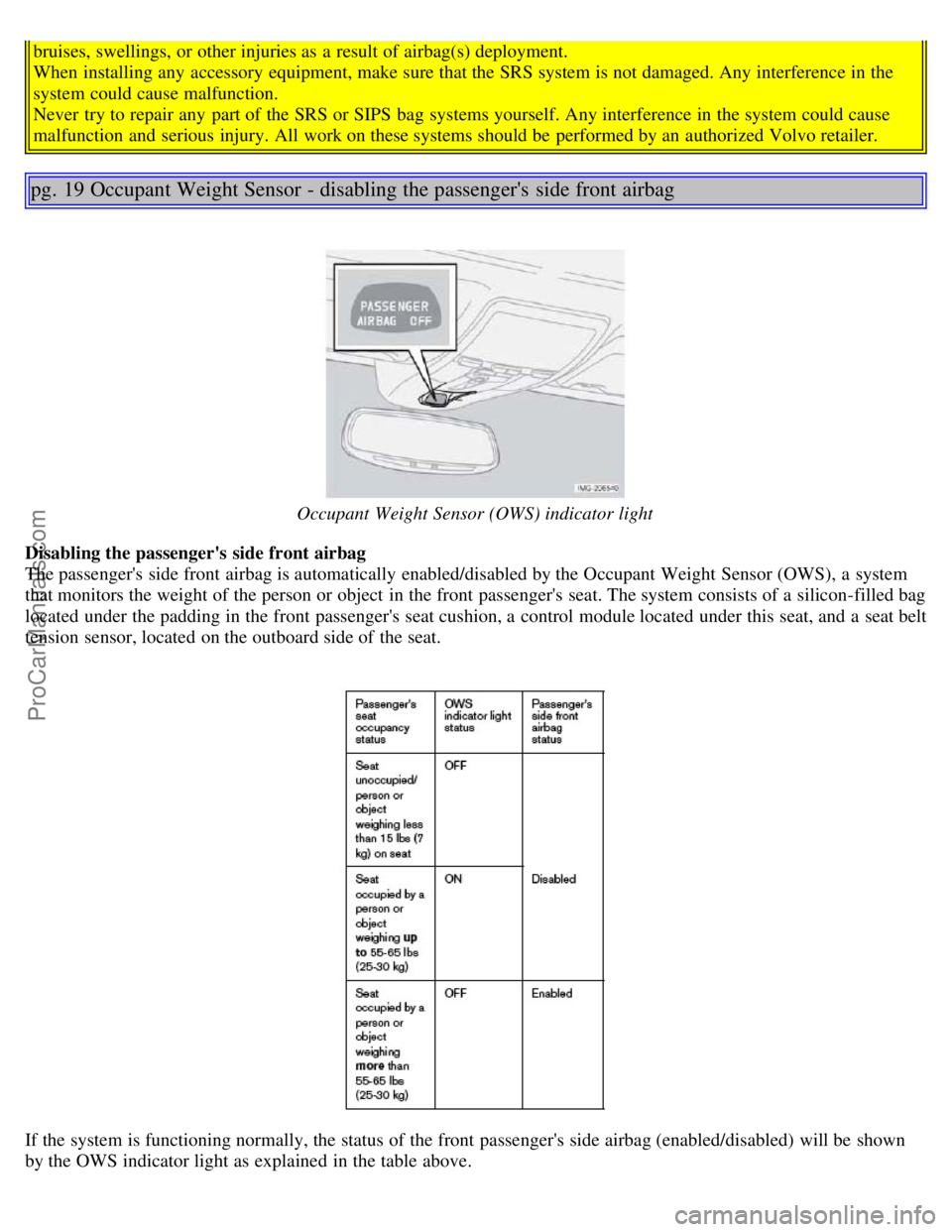
bruises, swellings, or other injuries as a result of airbag(s) deployment.
When installing any accessory equipment, make sure that the SRS system is not damaged. Any interference in the
system could cause malfunction.
Never try to repair any part of the SRS or SIPS bag systems yourself. Any interference in the system could cause
malfunction and serious injury. All work on these systems should be performed by an authorized Volvo retailer.
pg. 19 Occupant Weight Sensor - disabling the passenger's side front airbag
Occupant Weight Sensor (OWS) indicator light
Disabling the passenger's side front airbag
The passenger's side front airbag is automatically enabled/disabled by the Occupant Weight Sensor (OWS), a system
that monitors the weight of the person or object in the front passenger's seat. The system consists of a silicon-filled bag
located under the padding in the front passenger's seat cushion, a control module located under this seat, and a seat belt
tension sensor, located on the outboard side of the seat.
If the system is functioning normally, the status of the front passenger's side airbag (enabled/disabled) will be shown
by the OWS indicator light as explained in the table above.
ProCarManuals.com
Page 14 of 127
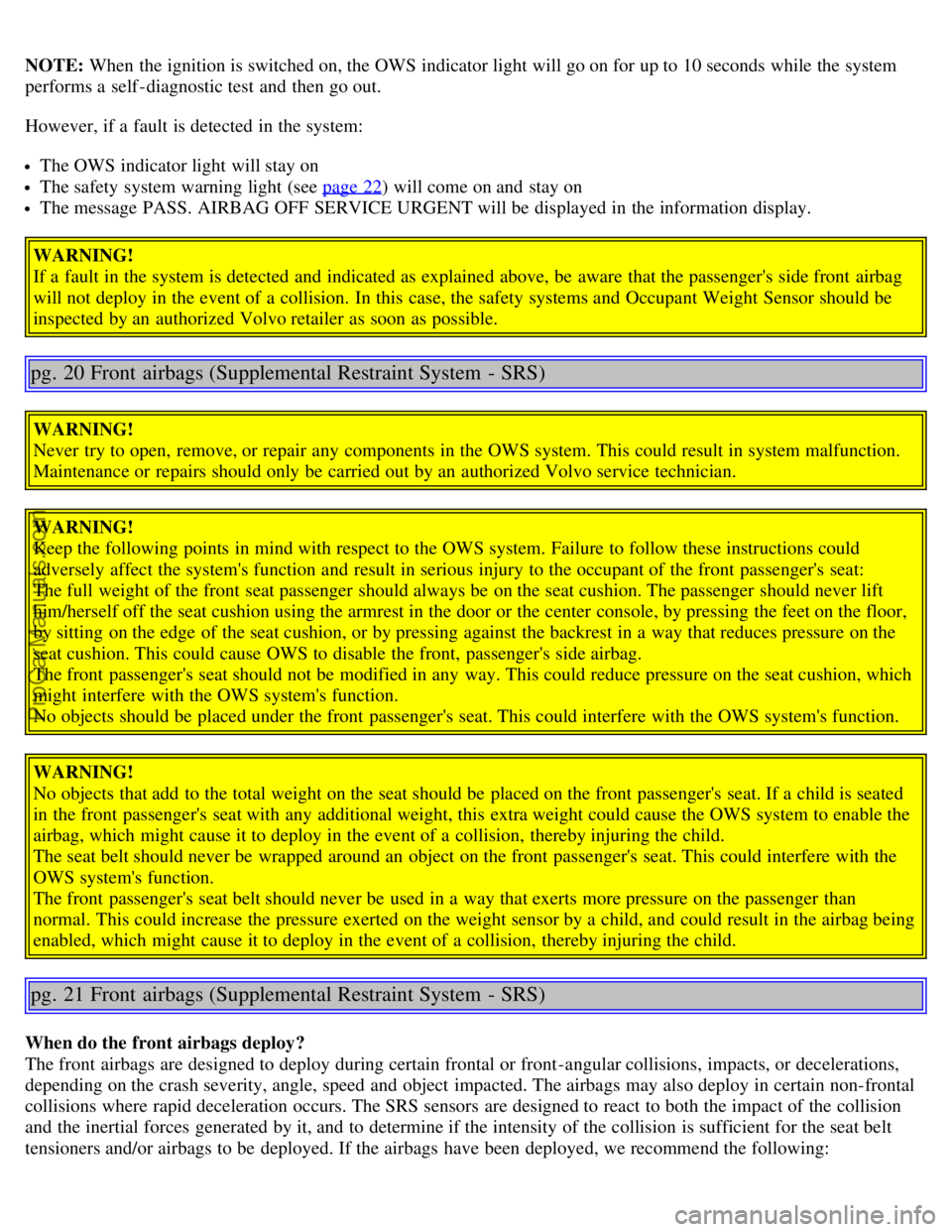
NOTE: When the ignition is switched on, the OWS indicator light will go on for up to 10 seconds while the system
performs a self -diagnostic test and then go out.
However, if a fault is detected in the system:
The OWS indicator light will stay on
The safety system warning light (see page 22) will come on and stay on
The message PASS. AIRBAG OFF SERVICE URGENT will be displayed in the information display.
WARNING!
If a fault in the system is detected and indicated as explained above, be aware that the passenger's side front airbag
will not deploy in the event of a collision. In this case, the safety systems and Occupant Weight Sensor should be
inspected by an authorized Volvo retailer as soon as possible.
pg. 20 Front airbags (Supplemental Restraint System - SRS)
WARNING!
Never try to open, remove, or repair any components in the OWS system. This could result in system malfunction.
Maintenance or repairs should only be carried out by an authorized Volvo service technician.
WARNING!
Keep the following points in mind with respect to the OWS system. Failure to follow these instructions could
adversely affect the system's function and result in serious injury to the occupant of the front passenger's seat:
The full weight of the front seat passenger should always be on the seat cushion. The passenger should never lift
him/herself off the seat cushion using the armrest in the door or the center console, by pressing the feet on the floor,
by sitting on the edge of the seat cushion, or by pressing against the backrest in a way that reduces pressure on the
seat cushion. This could cause OWS to disable the front, passenger's side airbag.
The front passenger's seat should not be modified in any way. This could reduce pressure on the seat cushion, which
might interfere with the OWS system's function.
No objects should be placed under the front passenger's seat. This could interfere with the OWS system's function.
WARNING!
No objects that add to the total weight on the seat should be placed on the front passenger's seat. If a child is seated
in the front passenger's seat with any additional weight, this extra weight could cause the OWS system to enable the
airbag, which might cause it to deploy in the event of a collision, thereby injuring the child.
The seat belt should never be wrapped around an object on the front passenger's seat. This could interfere with the
OWS system's function.
The front passenger's seat belt should never be used in a way that exerts more pressure on the passenger than
normal. This could increase the pressure exerted on the weight sensor by a child, and could result in the airbag being
enabled, which might cause it to deploy in the event of a collision, thereby injuring the child.
pg. 21 Front airbags (Supplemental Restraint System - SRS)
When do the front airbags deploy?
The front airbags are designed to deploy during certain frontal or front -angular collisions, impacts, or decelerations,
depending on the crash severity, angle, speed and object impacted. The airbags may also deploy in certain non-frontal
collisions where rapid deceleration occurs. The SRS sensors are designed to react to both the impact of the collision
and the inertial forces generated by it, and to determine if the intensity of the collision is sufficient for the seat belt
tensioners and/or airbags to be deployed. If the airbags have been deployed, we recommend the following:
ProCarManuals.com
Page 15 of 127
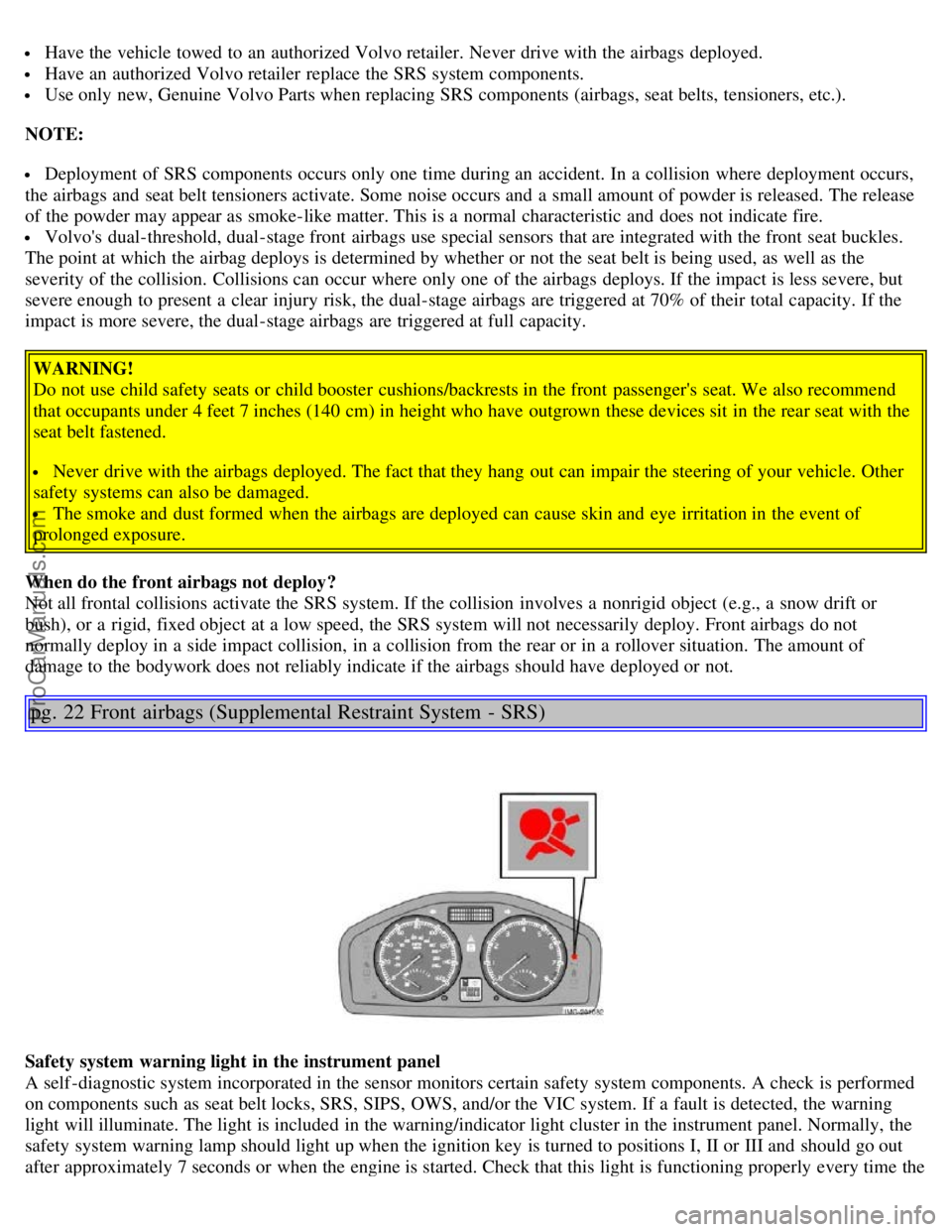
Have the vehicle towed to an authorized Volvo retailer. Never drive with the airbags deployed.
Have an authorized Volvo retailer replace the SRS system components.
Use only new, Genuine Volvo Parts when replacing SRS components (airbags, seat belts, tensioners, etc.).
NOTE:
Deployment of SRS components occurs only one time during an accident. In a collision where deployment occurs,
the airbags and seat belt tensioners activate. Some noise occurs and a small amount of powder is released. The release
of the powder may appear as smoke-like matter. This is a normal characteristic and does not indicate fire.
Volvo's dual-threshold, dual-stage front airbags use special sensors that are integrated with the front seat buckles.
The point at which the airbag deploys is determined by whether or not the seat belt is being used, as well as the
severity of the collision. Collisions can occur where only one of the airbags deploys. If the impact is less severe, but
severe enough to present a clear injury risk, the dual-stage airbags are triggered at 70% of their total capacity. If the
impact is more severe, the dual-stage airbags are triggered at full capacity.
WARNING!
Do not use child safety seats or child booster cushions/backrests in the front passenger's seat. We also recommend
that occupants under 4 feet 7 inches (140 cm) in height who have outgrown these devices sit in the rear seat with the
seat belt fastened.
Never drive with the airbags deployed. The fact that they hang out can impair the steering of your vehicle. Other
safety systems can also be damaged.
The smoke and dust formed when the airbags are deployed can cause skin and eye irritation in the event of
prolonged exposure.
When do the front airbags not deploy?
Not all frontal collisions activate the SRS system. If the collision involves a nonrigid object (e.g., a snow drift or
bush), or a rigid, fixed object at a low speed, the SRS system will not necessarily deploy. Front airbags do not
normally deploy in a side impact collision, in a collision from the rear or in a rollover situation. The amount of
damage to the bodywork does not reliably indicate if the airbags should have deployed or not.
pg. 22 Front airbags (Supplemental Restraint System - SRS)
Safety system warning light in the instrument panel
A self -diagnostic system incorporated in the sensor monitors certain safety system components. A check is performed
on components such as seat belt locks, SRS, SIPS, OWS, and/or the VIC system. If a fault is detected, the warning
light will illuminate. The light is included in the warning/indicator light cluster in the instrument panel. Normally, the
safety system warning lamp should light up when the ignition key is turned to positions I, II or III and should go out
after approximately 7 seconds or when the engine is started. Check that this light is functioning properly every time the
ProCarManuals.com
Page 16 of 127
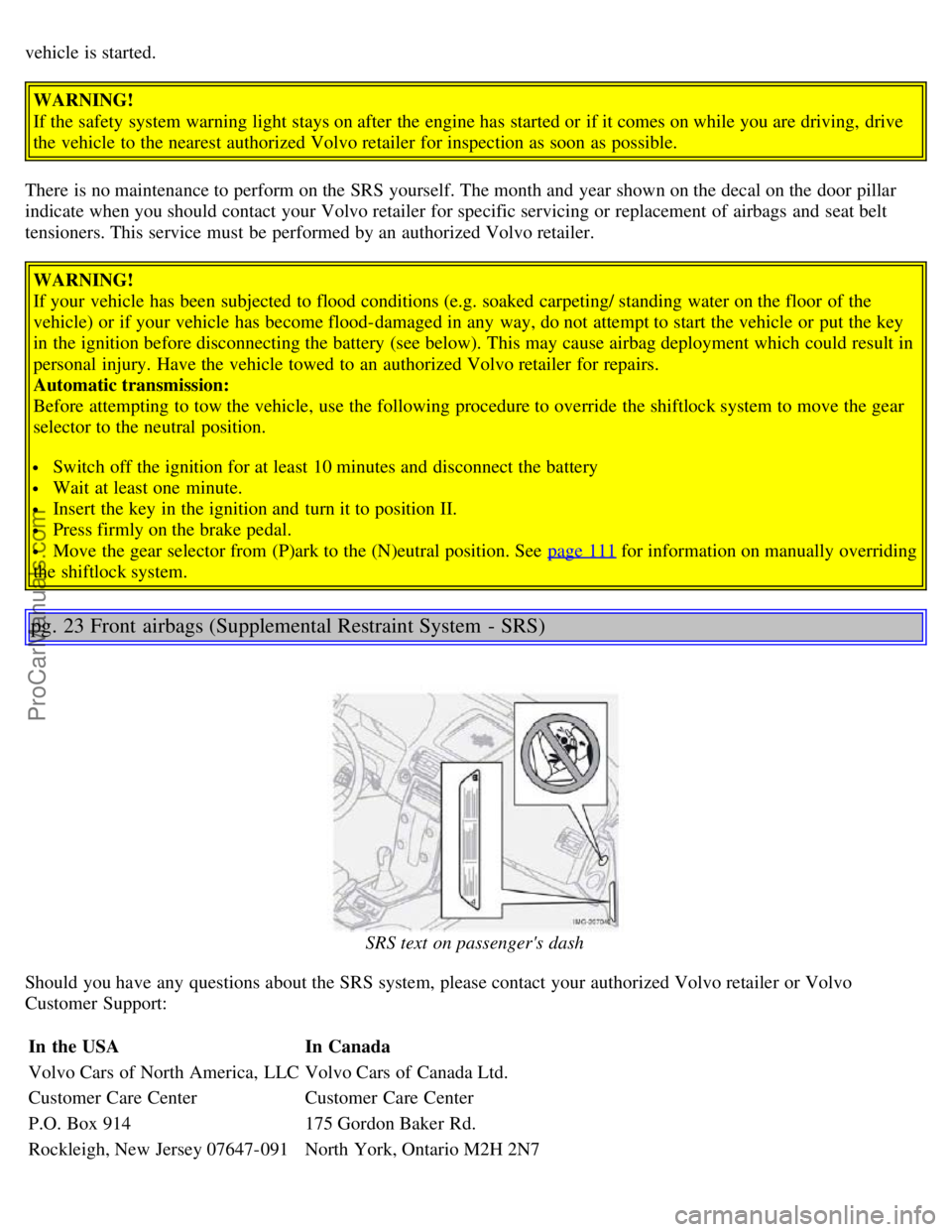
vehicle is started.
WARNING!
If the safety system warning light stays on after the engine has started or if it comes on while you are driving, drive
the vehicle to the nearest authorized Volvo retailer for inspection as soon as possible.
There is no maintenance to perform on the SRS yourself. The month and year shown on the decal on the door pillar
indicate when you should contact your Volvo retailer for specific servicing or replacement of airbags and seat belt
tensioners. This service must be performed by an authorized Volvo retailer. WARNING!
If your vehicle has been subjected to flood conditions (e.g. soaked carpeting/ standing water on the floor of the
vehicle) or if your vehicle has become flood-damaged in any way, do not attempt to start the vehicle or put the key
in the ignition before disconnecting the battery (see below). This may cause airbag deployment which could result in
personal injury. Have the vehicle towed to an authorized Volvo retailer for repairs.
Automatic transmission:
Before attempting to tow the vehicle, use the following procedure to override the shiftlock system to move the gear
selector to the neutral position.
Switch off the ignition for at least 10 minutes and disconnect the battery
Wait at least one minute.
Insert the key in the ignition and turn it to position II.
Press firmly on the brake pedal.
Move the gear selector from (P)ark to the (N)eutral position. See page 111 for information on manually overriding
the shiftlock system.
pg. 23 Front airbags (Supplemental Restraint System - SRS)
SRS text on passenger's dash
Should you have any questions about the SRS system, please contact your authorized Volvo retailer or Volvo
Customer Support:
In the USA In Canada
Volvo Cars of North America, LLC Volvo Cars of Canada Ltd.
Customer Care Center Customer Care Center
P.O. Box 914 175 Gordon Baker Rd.
Rockleigh, New Jersey 07647-091 North York, Ontario M2H 2N7
ProCarManuals.com
Page 17 of 127

1-800-458-15521-800-663-8255
SRS text on outside of both sun visors
SRS text on inside of both sun visors
WARNING!
Children must never be allowed in the front passenger's seat. Volvo recommends that ALL occupants (adults and
children) shorter than 4 feet 7 inches (140 cm) be seated in the back seat of any vehicle with a passenger -side front
airbag. See 35
for guidelines.
Occupants in the front passenger's seat must never sit on the edge of the seat, sit leaning toward the instrument panel
or otherwise sit out of position.
The occupant's back must be as upright as comfort allows and be against the seat back with the seat belt properly
fastened.
Feet must be on the floor, e.g. not on the dash, seat or out of the window.
pg. 24 Front airbags (Supplemental Restraint System - SRS)
WARNING!
No objects or accessory equipment, e.g. dashboard covers, may be placed on, attached to, or installed near the SRS
hatch (the area above the glove compartment) or the area affected by airbag deployment (see the illustration on page
17).
There should be no loose articles, e.g. coffee cups, on the floor, seat, or dashboard area.
Never try to open the SRS cover on the steering wheel or the passenger's side dashboard. This should only be done
by an authorized Volvo service technician. Failure to follow these instructions can result in injury to the vehicle
occupants.
Contents | Top of Page
ProCarManuals.com
Page 18 of 127
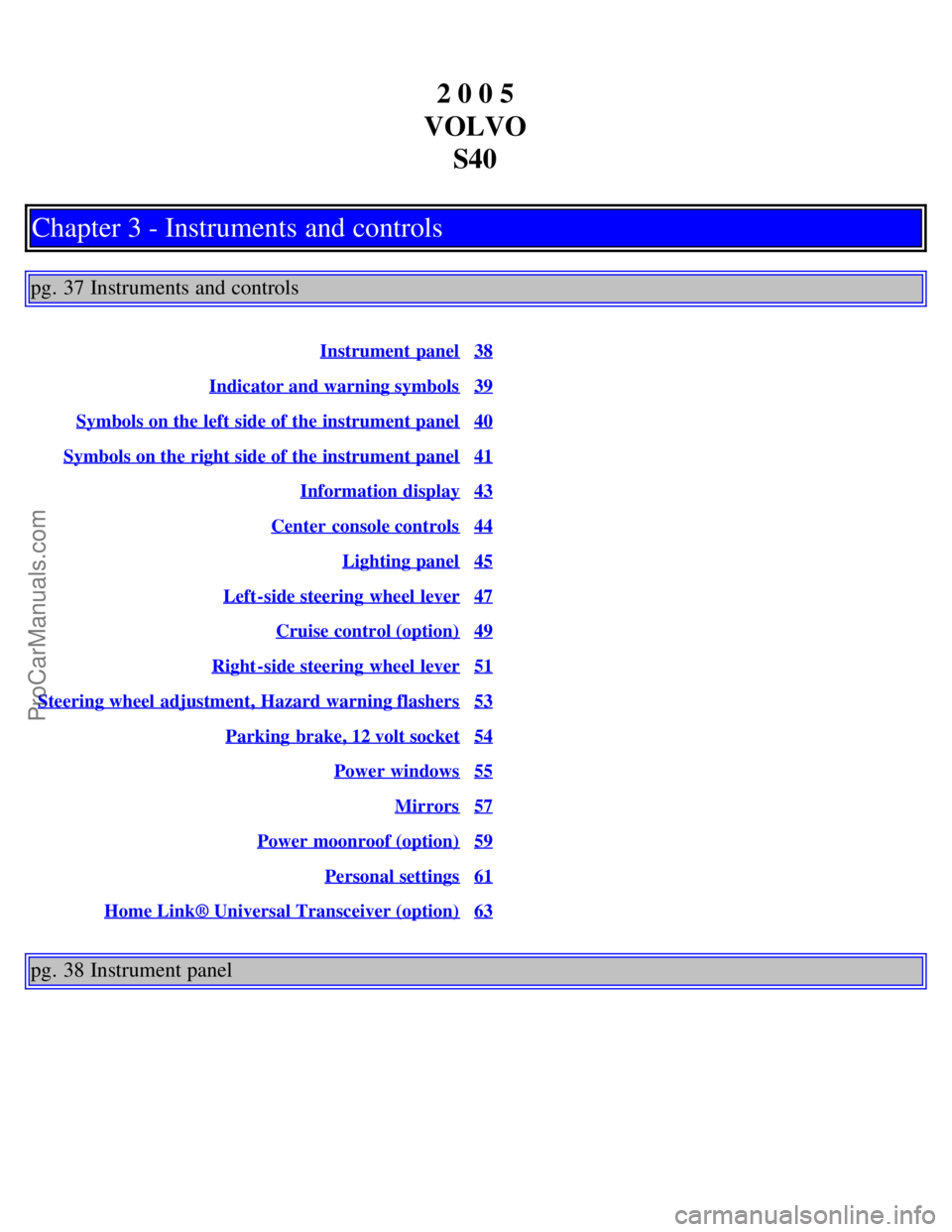
2 0 0 5
VOLVO S40
Chapter 3 - Instruments and controls
pg. 37 Instruments and controls
Instrument panel38
Indicator and warning symbols39
Symbols on the left side of the instrument panel40
Symbols on the right side of the instrument panel41
Information display43
Center console controls44
Lighting panel45
Left-side steering wheel lever47
Cruise control (option)49
Right-side steering wheel lever51
Steering wheel adjustment, Hazard warning flashers53
Parking brake, 12 volt socket54
Power windows55
Mirrors57
Power moonroof (option)59
Personal settings61
Home Link® Universal Transceiver (option)63
pg. 38 Instrument panel
ProCarManuals.com
Page 19 of 127

1. Speedometer
2. Turn signal, left
3. Warning symbol
See the next page for additional information.
4. Information display
The display presents information and warning messages, the ambient temperature, and the clock, etc. When the
ambient temperature is between 23° and 36°F (-5° and +2°C), a snowflake symbol is shown in the display. This
symbol serves as a warning for possible slippery road surfaces. Please note that this symbol does not indicate a fault
with your car. At low speeds, or when the car is not moving, the temperature readings may be slightly higher than the
actual ambient temperature.
5. Information symbol
See the next page for additional information.
6. Turn signal, right
7. Tachometer
The tachometer shows engine speed in thousands of revolutions per minute (rpm). Do not drive continuously with the
needle in the red area of the dial, which indicates maximum allowable engine rpm range. Instead, shift to a higher gear
or slow the vehicle down. The engine management system will automatically prevent excessively high engines speeds.
This will be noticeable as a pronounced unevenness in engine speed.
8. Indicator and warning symbols
9. Fuel gauge
The fuel tank holds approximately 15.9 US gallons (60 liters)
1. When a warning light in the gauge comes on, there are
approximately 2.1 US gallons (8 liters) of fuel remaining in the tank.
10. Trip odometer reset button
The trip odometers are used to measure short distances. Press the button briefly to switch between the odometer for the
car's total mileage and the two trip odometers, T1 and T2. A long press (more than 2 seconds) resets the currently
selected trip odometer.
11. Function display
This window displays information on functions such as the odometer, trip odometers, optional rain sensor, and cruise
control.
12. High beam indicator
13. Clock setting button
Turn the button to set the time.
ProCarManuals.com
Page 20 of 127

14. Temperature gauge
The gauge indicates the temperature of the engine cooling system. If the temperature is abnormally high and the needle
enters the red zone, a message is shown in the display. Bear in mind that extra lamps in front of the air intake reduce
the cooling capacity at high outside temperatures and high engine loads.
15. Indicator and warning symbols
1. Models with All Wheel Drive have a tank volume of 15 US gallons (57 liters).
Models with engine code 39 have a fuel tank capacity of 14.5 US gallons (55 liters). This code is the 6th and 7th digits
from the left in your vehicle's VIN number. See page 184
for the location of the VIN plate.
pg. 39 Indicator and warning symbols
Function check
The indicator and warning symbols light up when you turn the ignition key to the driving position (position II) before
starting. This shows that the symbols are functioning. When the engine starts, all symbols go out. If the engine is not
started within 5 seconds, all of the symbols except CHECK ENGINE and
will go out. Certain symbols may not
have their functions illustrated, depending on the car's equipment. The PARK BRAKE symbol will not go out until the
parking brake has been released.
Symbols in the center of the instrument panel
Warning symbol
The red warning symbol lights up to indicate a fault that could affect the car's driveability. A text explaining the nature
of the fault will also be shown in the information display. This symbol may also light up in combination with other
indicator or warning symbols.
If the red warning symbol lights up:
1. Stop the car as soon as possible in a suitable location.
2. Read the message in the information display.
3. Follow the instructions provided, or contact an authorized Volvo Retailer or workshop.
Information symbol
The yellow information symbol lights up to alert the driver to a message in the information display. This symbol may
also light up in combination with other indicator or warning symbols.
NOTE: The car can still be driven after the information symbol has come on. The car can be driven for 1-2 weeks
after service-related information has been displayed.
ProCarManuals.com